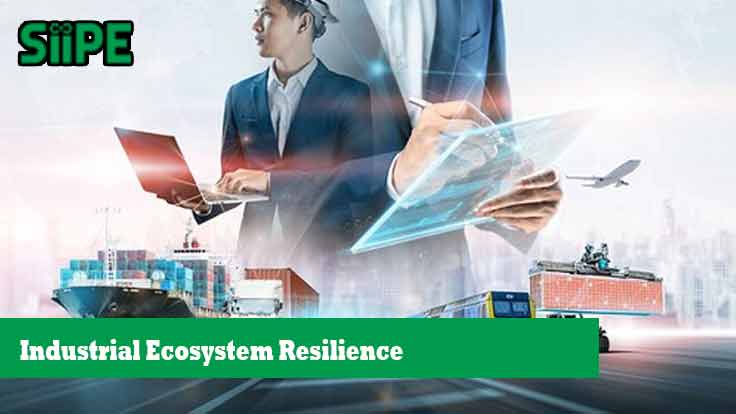In today’s increasingly volatile world, industrial zones are no longer just clusters of factories—they are complex ecosystems that must be resilient to survive and thrive. Industrial ecosystem resilience refers to the ability of industrial zones and supply chains to anticipate, absorb, adapt to, and recover from disruptions while maintaining continuous operation and sustainable development.
From natural disasters and pandemics to geopolitical tensions and economic shocks, the ability to bounce back—or better yet, to thrive in adversity—has become a critical differentiator in the global competition for investment and innovation.
What Is Industrial Ecosystem Resilience?
Industrial ecosystem resilience is the capability of an entire industrial environment—including infrastructure, supply chains, labor forces, supporting services, and governing institutions—to withstand disruptions without collapsing or suffering permanent damage.
It is not merely about bouncing back after a crisis, but also about proactively designing systems that can flex and adapt as conditions change.
Key characteristics of a resilient industrial ecosystem include:
-
Redundancy: Having backup systems and alternative suppliers
-
Flexibility: Ability to reconfigure quickly in response to change
-
Connectivity: Strong communication and coordination between stakeholders
-
Sustainability: Environmentally responsible and resource-efficient operations
-
Learning capacity: The ability to analyze failures and improve future responses
Why Resilience Matters in Industrial Zones
Many industrial zones are exposed to both internal and external risks. These may include:
-
Natural disasters (e.g., floods, earthquakes, fires)
-
Supply chain disruptions (e.g., global chip shortage, pandemic lockdowns)
-
Energy crises (e.g., fuel price spikes, power outages)
-
Political and regulatory changes
-
Cybersecurity threats
Resilient zones can handle these shocks better, ensuring business continuity and protecting the investments of tenants, developers, and governments.
Core Pillars of a Resilient Industrial Ecosystem
1. Infrastructure Resilience
Strong, smart, and well-maintained infrastructure is the foundation of resilience. This includes:
-
Earthquake-resistant buildings
-
Flood mitigation systems
-
Redundant power and water systems
-
High-speed internet and secure data centers
-
Transportation networks with alternative routes
Investing in climate-resilient infrastructure can also reduce long-term operational costs and downtime.
2. Supply Chain Agility
Industrial zones are only as strong as their weakest supplier. Developing a robust supply chain strategy involves:
-
Diversifying vendors and logistics partners
-
Nearshoring and reshoring to reduce dependency
-
Using digital platforms for real-time supply tracking
-
Building buffer stocks of critical components
Tools like blockchain and AI are now used to improve visibility and risk prediction across the supply chain.
3. Workforce and Community Engagement
A resilient workforce is trained, adaptive, and engaged. This means:
-
Ongoing upskilling and reskilling programs
-
Ensuring worker safety and well-being
-
Developing strong ties with surrounding communities
-
Promoting inclusive hiring practices
Zones that invest in their people are more adaptable and better positioned to recover after crises.
4. Governance and Policy Support
Supportive policies and governance frameworks help ensure quick decision-making and clarity during emergencies. This includes:
-
Clear crisis response protocols
-
Integrated disaster response centers
-
Incentives for businesses to invest in resilience
-
Transparent communication channels between tenants and authorities
Government involvement also helps unlock funding for resilience-building efforts.
5. Technology and Innovation
Smart technologies like IoT, big data, and predictive analytics empower industrial zones to monitor real-time risks and respond dynamically. Examples:
-
Smart meters to detect energy overuse
-
AI-driven maintenance alerts
-
Remote asset management during lockdowns
-
Digital twins to simulate disaster responses
Innovation hubs within industrial parks can also foster collaborative solutions to shared challenges.
Case Study: Japan’s Approach to Industrial Resilience
Japan, frequently hit by earthquakes and tsunamis, has become a global leader in industrial resilience. Their industrial zones are equipped with:
-
Underground power lines
-
Smart flood control systems
-
Emergency bunkers and evacuation routes
-
Employee disaster training and drills
After the 2011 Tōhoku earthquake and tsunami, many zones were rebuilt with resilient design at their core, proving that post-disaster reconstruction can lead to long-term improvements.
Benefits of Investing in Resilience
Investing in resilience is not just a defensive move—it provides strategic advantages:
-
Reduced downtime: Faster recovery after disruptions
-
Lower insurance premiums: Due to risk mitigation measures
-
Increased investor confidence: Stable operations attract long-term investment
-
Regulatory compliance: Especially for ESG-focused stakeholders
-
Positive brand reputation: Businesses seen as responsible and prepared
In the long run, resilient zones become hubs for innovation, employment, and sustainable growth.
Practical Steps for Developers and Tenants
For industrial developers and tenants looking to enhance ecosystem resilience, here are actionable steps:
-
Conduct vulnerability assessments regularly
-
Invest in smart infrastructure and monitoring systems
-
Create emergency response and business continuity plans
-
Diversify suppliers and logistics partners
-
Engage with local authorities and emergency services
-
Run regular resilience training for employees
-
Monitor ESG metrics and report transparently
Challenges in Building Resilience
Despite its importance, building resilience comes with hurdles:
-
High upfront costs for infrastructure upgrades
-
Lack of awareness or urgency among stakeholders
-
Limited technical expertise in resilience planning
-
Conflicting interests between profit and long-term safety
However, the long-term economic and social returns far outweigh these challenges.
The Future of Resilient Industrial Ecosystems
As climate change accelerates and global supply chains face new threats, resilience will become a central metric in evaluating industrial zones.
Future trends may include:
-
ESG-linked financing for resilient zones
-
Carbon-neutral industrial parks powered by renewable energy
-
AI-driven risk management systems
-
Collaborative resilience networks between multiple zones
By embracing these innovations, industrial zones can evolve from vulnerable systems into adaptive ecosystems.
Industrial ecosystem resilience is no longer optional—it is a necessity. In a world of unpredictable shocks, industrial zones must be ready not only to endure but also to evolve.
Through smart planning, collaboration, and innovation, we can turn today’s fragile supply chains and infrastructure into tomorrow’s resilient growth engines.








